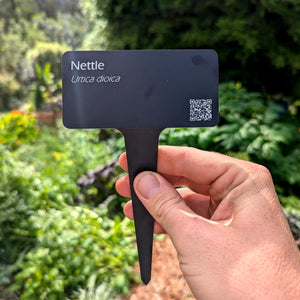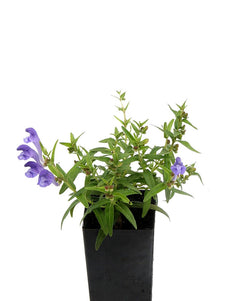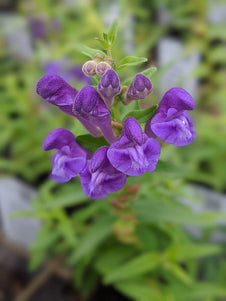











Baikal Skullcap
Baikal Skullcap

- In stock, ready to ship
- Inventory on the way

Usually available: October to March
Life cycle: Herbaceous Perennial
Height: 30cm
Position: Sun / part shade
Soil preference: Well drained
This is how we pack and send your Herb Plants to all states except TAS & WA
You will receive
- 1 Baikal Skullcap Herb Plant in a 50 X 75mm tube - General growing instructions
All of our Herb Plants are grown organically with certified organic potting mixes and fertilizers
Botanical Name:Scutellaria baicalensis
Baikal Skullcap is a low growing, perennial shrub reaching only 30cm in height, but spreading up to 50-60cm wide. The tubular flowers are held in dense one sided racemes, with long stalks giving the plant more height. The blue-purple flowers have a helmet shape on the top and a wider, skirt like lobe at the base. The blooms appear in late spring to summer and into autumn, but the timing may be somewhat climate dependent. The dark green leaves are spear shaped, quite long and thin, extending out from the stems. The stems spread along the ground and then extend up at the tips. The roots have medicinal value and are dark brown and woody, on the outside, and bright yellow inside.
Scutellaria baicalensis is part of the Laminaceae or mint family. The genus name references the shape of the calyx with the Latin word for a small dish ‘scutella’. The common name ‘skullcap’ refers to the medieval term for small medieval helmets. The species name ‘baicalensis’ is taken from Lake Baikal, the native habitat of the plant. There are many similar species growing in different countries, all of which may be given the localized name of ‘skullcap’ or ‘scullcap’. To prevent confusion it is important to check the species name of the plant. For example, there is often confusion between Scutellaria baicalensis, Scutellaria lateriflora and Scutellaria barbata, with the latter two plants being given the name Baikal Skullcap by many gardeners in North America.
Baikal Skullcap grows at 100-200 meters above sea level and is part of the rich biodiversity of flora and fauna native to the Lake Baikal region, in Siberia. Lake Baikal is a rift valley lake and is the earth’s deepest lake at 1642 meters deep. It also has the largest volume, holding 20% of the unfrozen freshwater found on earth. The lake is surrounded by the Baikal Mountains, has numerous islands and is the 7th largest freshwater lake in area. Up to 80% of the plants and animals found at Lake Baikal are unique to the area. However Baikal Skullcap is also found in Mongolia, Korea and parts of China. It may be called Chinese Skullcap or Huang Qin in Chinese Traditional Medicine.
Growing Conditions
Baikal Skullcap prefers a sunny to part shade position, with a light soil if possible. The soil should be well drained, but should not dry out completely. The potency of the active chemicals in the roots is said to be greater if the plant is grown in poor, sandy soils. Once established this plant is said to have average water needs and to be drought tolerant. It is quite hardy, easy to grow and will also tolerate low temperatures and frost. The temperatures in the native habitat are generally quite low, compared to those found in Australia.
Although this plant is perennial, the life cycle may be as short as three years, so an ongoing supply of new plants is quite useful. The seed for Baikal Skullcap may be sown in spring or the plants may be divided, before new spring growth appears. Larger divisions may be planted out, while smaller sections may be kept in pots until ready for the garden. Woody or soft stem cuttings may also be taken from plant and many people have success with tip layering. This plant is also suitable for container growing.
Medicinal Uses
Baikal Skullcap is one of the 50 fundamental herbs used in Traditional Chinese Medicine, for over 2000 years. It is mostly used for ‘hot and damp’ conditions, such as inflammation or infection, and for calming the nerves and anxiety. Conditions it may be used for in TCM include fever, jaundice, dysentery, diarrhoea, urinary tract infections, liver disease, prostrate cancer, respiratory infections, arthritis, and for anti-coagulate purposes.
Modern research has found significant support for the effectiveness of active chemicals found in the root of this plant. However, not enough research has been done to determine if there is a truly effective dosage level and the true benefits of each constituent. Potential exists for activities including, anti-bacterial, anti-inflammatory, anti-cancer, anti-anxiety, anti-hypertensive and liver protective effects. There are also reports of anti-allergenic activity, sedative and anxiety reduction, assistance with respiratory conditions, including hay fever, and allergic skin conditions such as eczema and psoriasis.
Baikal Skullcap has been determined to have low order toxicity, with most people unlikely to be adversely affected by normal use. The active components in this plant may react with alcohol and some medications including, Lithium, sedatives, statins used for high cholesterol and diabetes medication. In some people this plant may cause drowsiness, an allergic reaction and /or lead to liver problems. Baikal Skullcap should be avoided by pregnant or breastfeeding women.
The root of the plant is used for traditional medicine, leading to the common name Baikal Skullcap Root. The active constituents in the plant take time to accumulate, so the roots should only be harvested on 3-4 year old plants, preferably in spring and autumn. Leave the roots to dry in a partly shaded and well-ventilated area. They may be left whole, or simply sliced for later use, including making a tea substitute. However, note that good quality roots should be brown outside and yellow inside, not green or black.
Scutellaria baicalensis is cultivated commercially due to the high level of flavonoids found in the roots of 3-4 year old plants. The active chemicals include baicalein, wogonin and baicalin.
Culinary Uses
The roots may be harvested from 3-4 year old plants in spring and autumn. They do have a bitter taste and have medicinal uses. However, the leaves may be used for salads and vegetable dishes. The taste may vary from sweet to bitter, depending upon whether young or older leaves are used.
All information provided on this website is for informational purposes only. Please seek professional advice before commencing any treatment.






